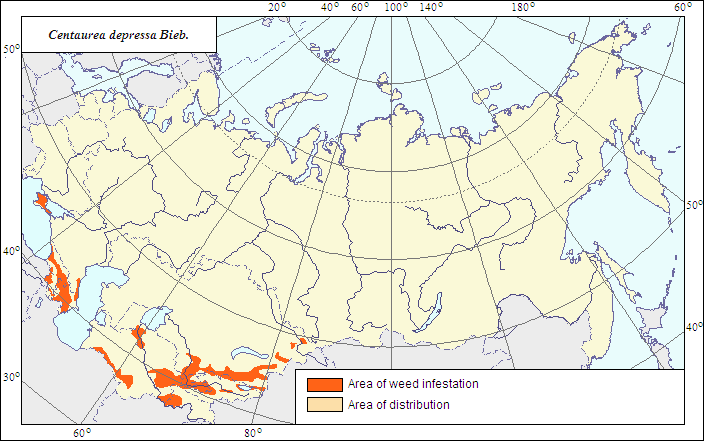Weeds
Area of distribution and weediness of Centaurea depressa Bieb.
 Object description Download GIS-layers
Object description Download GIS-layers
Authors:
Specialist-biologist T.D. Sokolova,GIS-specialist I.A.Budrevskaya.
Date of creation:
07.05.2007.Scale:
1:20 000 000.Accuracy of the map:
It is created on literature data.Projection:
"Alber's Equal Area Conic" USSR, 9, 1001, 7, 100, 0, 44, 68, 0, 0.Basic contents:
Vector map. Area is shown by polygons (main distribution). Zone of weediness is shown by polygons.Accuracy of the classifier:
Within the weed area, the area of main distribution coincides with the zone of weediness, where C. depressa is a pernicious weed. The zone of weediness is established by criteria of occurrence of this species and abundance (Tanskii V.I. et al., 1998). In the limits of this zone, C.depressa is characterized by 75% frequency of occurrence and 4 points of abundance.Method of map production:
The area of main distribution is drawn according to Nikitin V.V. (1979; 1983), Keller B.A. et al. (1935), Ulyanova T.N. (1981), Visyulina O.D. (1970). According to Nikitin V.V. (1983), C.depressa is a typical segetal weed plant, which occurs very seldom in natural phytocenoses and infests crops very abundantly in the limits of its area; therefore, the zone of weediness of C.depressa coincides with the area of its main distribution. Limits of the area of main distribution and zone of weediness are specified in accordance with data on abundance and frequency of the species occurrence taken from below-mentioned references, and are adjusted to the limits of arable lands. According to Nikitin V.V. (1979, 1983), C.depressa infests abundantly grain crops in the lower mountain zone in Central Asia, Southern Kazakhstan, the Caucasus, Transcaucasia, and Crimea. According to Ulyanova T.N. (1981), C.depressa is one of the main pernicious weeds of wheat in Crimea, the Caucasus, and Central Asia.Reference citations:
Grossgeim A.A. 1949. Keys to plants of the Caucasus. Moscow, 747 p. (in Russian).Keller B.A., Lyubimenko V.N., Maltsev A.I., Fedtshenko B.A., Shishkin B.K., Rodzevich R.Yu., Kamenskii K.V., eds. 1935. Weed plants of the USSR. V. 4. Moscow & Leningrad: AN USSR, 416 p. (in Russian).
Nikitin V.V. 1979. Geographical distribution of the most important weed species of the USSR and their dynamics. Botanicheskii zhurnal 64(7): 943-949 (in Russian).
Nikitin V.V. 1983. Weed plants in the flora of the USSR. Leningrad: Nauka, 454 p. (in Russian).
Tanskii V.I., Levitin M.M., Ishkova T.I. & Kondratenko V.I. 1998. Phytosanitary diagnostics in integrated management of cereals. In: Novozhilov K.V., ed. Compendium of methodical recommendations in plant protection. St.-Petersburg: VIZR, p. 5-55 (in Russian).
Ulyanova T.N. 1981. Weed plants in wheat of the USSR. In: Korovina O.N., ed. Catalogue of VIR world collection. Issue 320. Leningrad: VIR, 68 p. (in Russian).
Vasilchenko I.T., ed. 1953. Weed plants of Tajikistan. V. 1. Moscow-Leningrad: AN SSSR, 451 p. (in Russian).
Vasilchenko I.T. & Pidotti O.A. 1975. Keys to weed plants of areas of irrigated agriculture. Leningrad: Kolos, 376 p. (in Russian).
Visyulina O.D., ed. 1970. Weeds of the Ukraine. Kiev: Naukova dumka, 508 p. (in Ukrainian).

